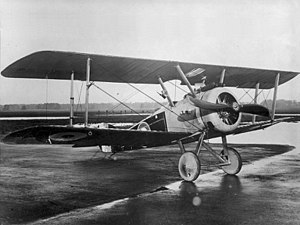Sopwith Camels
| Camel | |
|---|---|
 |
|
| Sopwith Camel | |
| Role | Biplane fighter |
| Manufacturer | Sopwith Aviation Company |
| Designer | Herbert Smith |
| First flight | 22 December 1916 |
| Introduction | June 1917 |
| Retired | January 1920 |
| Primary users |
Royal Flying Corps Royal Naval Air Service Royal Air Force |
| Number built | 5,490 |
| Developed from | Sopwith Pup |
The Sopwith Camel was a British First World War single-seat biplane fighter aircraft introduced on the Western Front in 1917. It had been developed by the Sopwith Aviation Company as a successor to the earlier Sopwith Pup and would become one of the most iconic fighter aircraft of the First World War.
The Camel was powered by a single rotary engine and was armed with twin synchronized machine guns. Though proving difficult to handle, it provided for a high level of manoeuvrability to an experienced pilot, an attribute which was highly valued in the type's principal use as a fighter aircraft. In total, Camel pilots have been credited with the shooting down of 1,294 enemy aircraft, more than any other Allied fighter of the conflict. Towards the end of the Great War, the type had also seen use as a ground-attack aircraft, partially due to it having become increasingly outclassed as the capabilities of fighter aircraft on both sides was rapidly advancing at that time.
The main variant of the Camel was designated as the F.1; several dedicated variants were built for a variety of roles, including the 2F.1 Ship's Camel, which was used for operating from the flight decks of aircraft carriers, the Comic night fighter variant, and the T.F.1, a dedicated 'trench fighter' that had been armoured for the purpose of conducting ground attacks upon heavily defended enemy lines. The Camel also saw use as a two-seat trainer aircraft. In January 1920, the last aircraft of the type were withdrawn from RAF service.
The Camel's predecessor, the Sopwith Pup, was no longer competitive against newer German fighters, such as the Albatros D.III, and thus the Camel was developed specifically to replace the Pup, as well as the Nieuport 17s that had been purchased from the French as an interim measure. It was recognised that the new fighter would need to be faster and have a heavier armament. The design effort to produce this successor, initially designated as the Sopwith F.1, was headed by Sopwith's chief designer, Herbert Smith.
...
Wikipedia
